A Report on Effective Team Working and Communication Strategies
VerifiedAdded on 2023/01/09
|15
|4138
|78
Report
AI Summary
This report delves into the critical aspects of effective team working and communication within a professional environment. It begins by defining team working and communication, emphasizing their significance in enhancing efficiency, quality, and team spirit. The report highlights the importance of communication skills and their impact on individual and organizational growth, referencing a case study involving miscommunication between Maria and Pedro to illustrate practical challenges and potential solutions. The core of the report examines various communication models, including the Shannon and Weaver, Schramm, and Berlo models, providing detailed explanations and examples of each. The report explores verbal and non-verbal communication techniques and the crucial skill of active listening. It also discusses how these models facilitate understanding and overcome barriers, such as noise and misinterpretation, to achieve effective communication within teams. The report concludes by summarizing the key takeaways and reinforcing the importance of communication skills in the workplace.
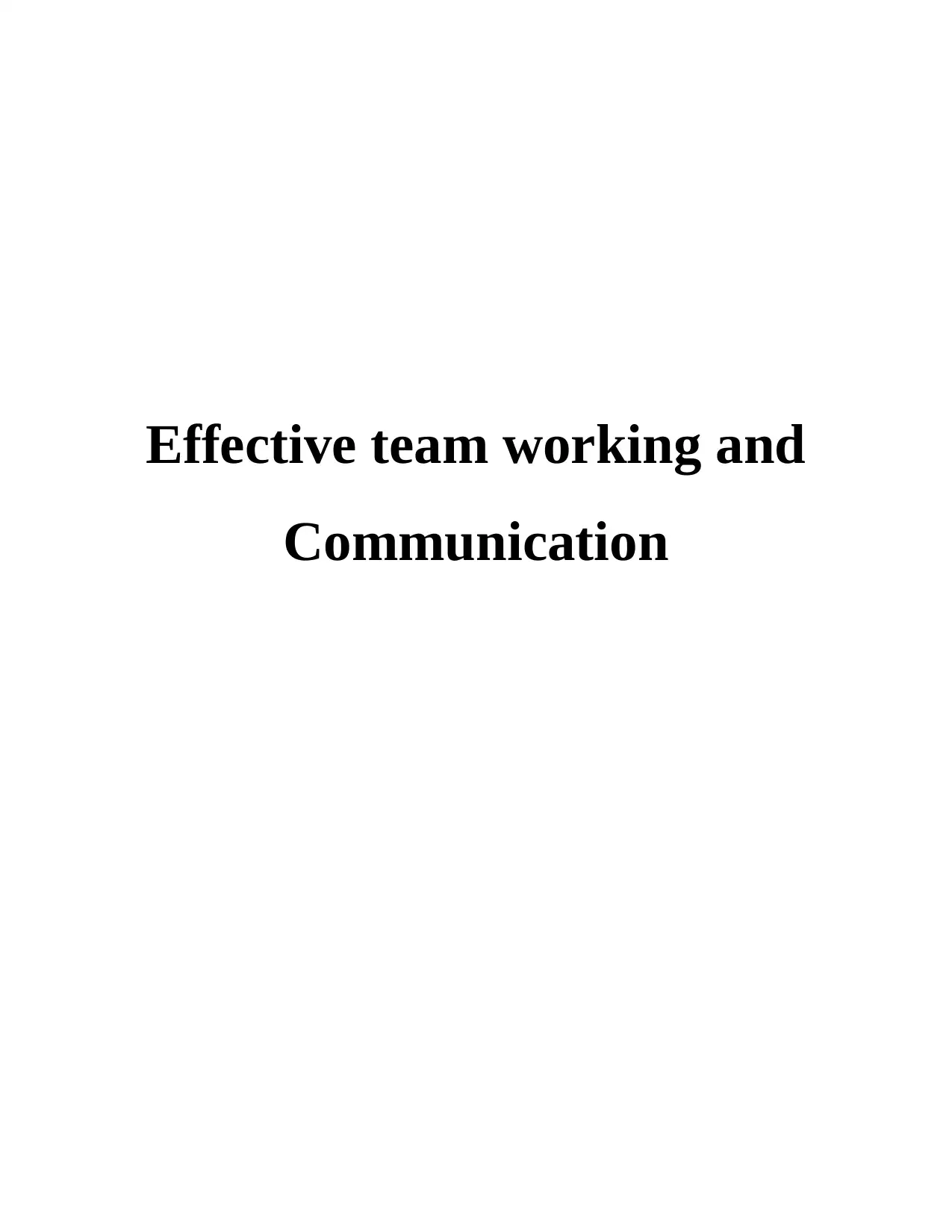
Effective team working and
Communication
Communication
Paraphrase This Document
Need a fresh take? Get an instant paraphrase of this document with our AI Paraphraser
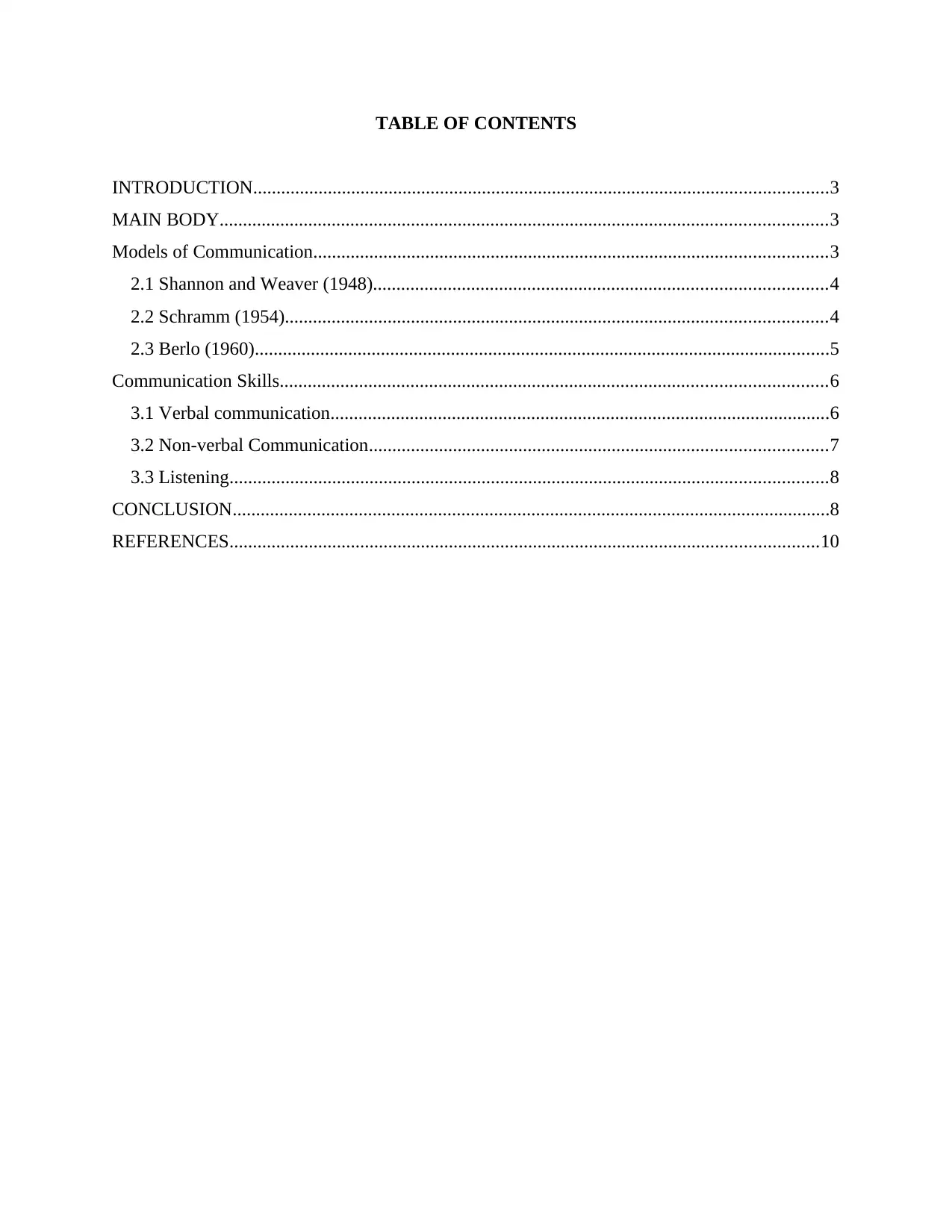
TABLE OF CONTENTS
INTRODUCTION...........................................................................................................................3
MAIN BODY..................................................................................................................................3
Models of Communication..............................................................................................................3
2.1 Shannon and Weaver (1948).................................................................................................4
2.2 Schramm (1954)....................................................................................................................4
2.3 Berlo (1960)...........................................................................................................................5
Communication Skills.....................................................................................................................6
3.1 Verbal communication...........................................................................................................6
3.2 Non-verbal Communication..................................................................................................7
3.3 Listening................................................................................................................................8
CONCLUSION................................................................................................................................8
REFERENCES..............................................................................................................................10
INTRODUCTION...........................................................................................................................3
MAIN BODY..................................................................................................................................3
Models of Communication..............................................................................................................3
2.1 Shannon and Weaver (1948).................................................................................................4
2.2 Schramm (1954)....................................................................................................................4
2.3 Berlo (1960)...........................................................................................................................5
Communication Skills.....................................................................................................................6
3.1 Verbal communication...........................................................................................................6
3.2 Non-verbal Communication..................................................................................................7
3.3 Listening................................................................................................................................8
CONCLUSION................................................................................................................................8
REFERENCES..............................................................................................................................10
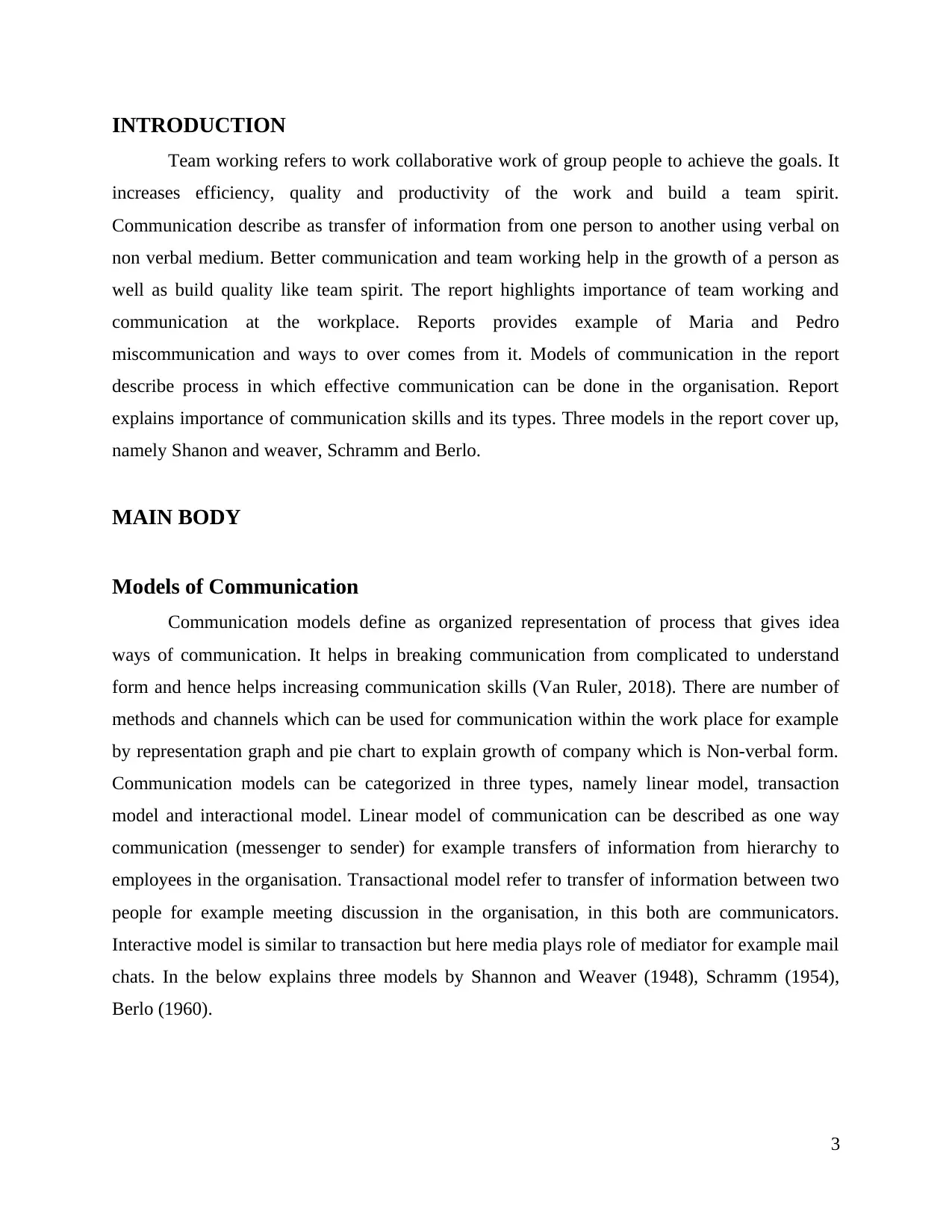
INTRODUCTION
Team working refers to work collaborative work of group people to achieve the goals. It
increases efficiency, quality and productivity of the work and build a team spirit.
Communication describe as transfer of information from one person to another using verbal on
non verbal medium. Better communication and team working help in the growth of a person as
well as build quality like team spirit. The report highlights importance of team working and
communication at the workplace. Reports provides example of Maria and Pedro
miscommunication and ways to over comes from it. Models of communication in the report
describe process in which effective communication can be done in the organisation. Report
explains importance of communication skills and its types. Three models in the report cover up,
namely Shanon and weaver, Schramm and Berlo.
MAIN BODY
Models of Communication
Communication models define as organized representation of process that gives idea
ways of communication. It helps in breaking communication from complicated to understand
form and hence helps increasing communication skills (Van Ruler, 2018). There are number of
methods and channels which can be used for communication within the work place for example
by representation graph and pie chart to explain growth of company which is Non-verbal form.
Communication models can be categorized in three types, namely linear model, transaction
model and interactional model. Linear model of communication can be described as one way
communication (messenger to sender) for example transfers of information from hierarchy to
employees in the organisation. Transactional model refer to transfer of information between two
people for example meeting discussion in the organisation, in this both are communicators.
Interactive model is similar to transaction but here media plays role of mediator for example mail
chats. In the below explains three models by Shannon and Weaver (1948), Schramm (1954),
Berlo (1960).
3
Team working refers to work collaborative work of group people to achieve the goals. It
increases efficiency, quality and productivity of the work and build a team spirit.
Communication describe as transfer of information from one person to another using verbal on
non verbal medium. Better communication and team working help in the growth of a person as
well as build quality like team spirit. The report highlights importance of team working and
communication at the workplace. Reports provides example of Maria and Pedro
miscommunication and ways to over comes from it. Models of communication in the report
describe process in which effective communication can be done in the organisation. Report
explains importance of communication skills and its types. Three models in the report cover up,
namely Shanon and weaver, Schramm and Berlo.
MAIN BODY
Models of Communication
Communication models define as organized representation of process that gives idea
ways of communication. It helps in breaking communication from complicated to understand
form and hence helps increasing communication skills (Van Ruler, 2018). There are number of
methods and channels which can be used for communication within the work place for example
by representation graph and pie chart to explain growth of company which is Non-verbal form.
Communication models can be categorized in three types, namely linear model, transaction
model and interactional model. Linear model of communication can be described as one way
communication (messenger to sender) for example transfers of information from hierarchy to
employees in the organisation. Transactional model refer to transfer of information between two
people for example meeting discussion in the organisation, in this both are communicators.
Interactive model is similar to transaction but here media plays role of mediator for example mail
chats. In the below explains three models by Shannon and Weaver (1948), Schramm (1954),
Berlo (1960).
3
⊘ This is a preview!⊘
Do you want full access?
Subscribe today to unlock all pages.

Trusted by 1+ million students worldwide
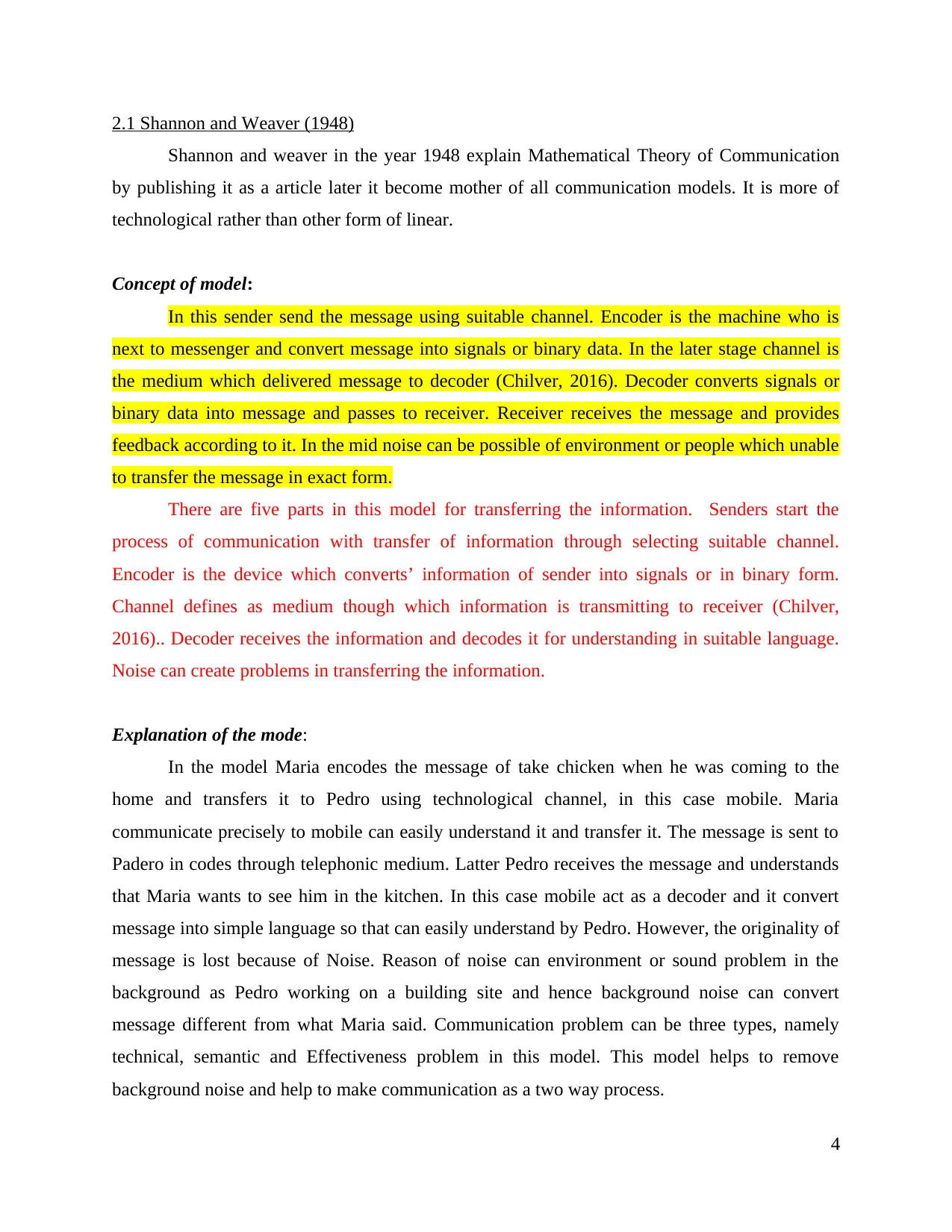
2.1 Shannon and Weaver (1948)
Shannon and weaver in the year 1948 explain Mathematical Theory of Communication
by publishing it as a article later it become mother of all communication models. It is more of
technological rather than other form of linear.
Concept of model:
In this sender send the message using suitable channel. Encoder is the machine who is
next to messenger and convert message into signals or binary data. In the later stage channel is
the medium which delivered message to decoder (Chilver, 2016). Decoder converts signals or
binary data into message and passes to receiver. Receiver receives the message and provides
feedback according to it. In the mid noise can be possible of environment or people which unable
to transfer the message in exact form.
There are five parts in this model for transferring the information. Senders start the
process of communication with transfer of information through selecting suitable channel.
Encoder is the device which converts’ information of sender into signals or in binary form.
Channel defines as medium though which information is transmitting to receiver (Chilver,
2016).. Decoder receives the information and decodes it for understanding in suitable language.
Noise can create problems in transferring the information.
Explanation of the mode:
In the model Maria encodes the message of take chicken when he was coming to the
home and transfers it to Pedro using technological channel, in this case mobile. Maria
communicate precisely to mobile can easily understand it and transfer it. The message is sent to
Padero in codes through telephonic medium. Latter Pedro receives the message and understands
that Maria wants to see him in the kitchen. In this case mobile act as a decoder and it convert
message into simple language so that can easily understand by Pedro. However, the originality of
message is lost because of Noise. Reason of noise can environment or sound problem in the
background as Pedro working on a building site and hence background noise can convert
message different from what Maria said. Communication problem can be three types, namely
technical, semantic and Effectiveness problem in this model. This model helps to remove
background noise and help to make communication as a two way process.
4
Shannon and weaver in the year 1948 explain Mathematical Theory of Communication
by publishing it as a article later it become mother of all communication models. It is more of
technological rather than other form of linear.
Concept of model:
In this sender send the message using suitable channel. Encoder is the machine who is
next to messenger and convert message into signals or binary data. In the later stage channel is
the medium which delivered message to decoder (Chilver, 2016). Decoder converts signals or
binary data into message and passes to receiver. Receiver receives the message and provides
feedback according to it. In the mid noise can be possible of environment or people which unable
to transfer the message in exact form.
There are five parts in this model for transferring the information. Senders start the
process of communication with transfer of information through selecting suitable channel.
Encoder is the device which converts’ information of sender into signals or in binary form.
Channel defines as medium though which information is transmitting to receiver (Chilver,
2016).. Decoder receives the information and decodes it for understanding in suitable language.
Noise can create problems in transferring the information.
Explanation of the mode:
In the model Maria encodes the message of take chicken when he was coming to the
home and transfers it to Pedro using technological channel, in this case mobile. Maria
communicate precisely to mobile can easily understand it and transfer it. The message is sent to
Padero in codes through telephonic medium. Latter Pedro receives the message and understands
that Maria wants to see him in the kitchen. In this case mobile act as a decoder and it convert
message into simple language so that can easily understand by Pedro. However, the originality of
message is lost because of Noise. Reason of noise can environment or sound problem in the
background as Pedro working on a building site and hence background noise can convert
message different from what Maria said. Communication problem can be three types, namely
technical, semantic and Effectiveness problem in this model. This model helps to remove
background noise and help to make communication as a two way process.
4
Paraphrase This Document
Need a fresh take? Get an instant paraphrase of this document with our AI Paraphraser
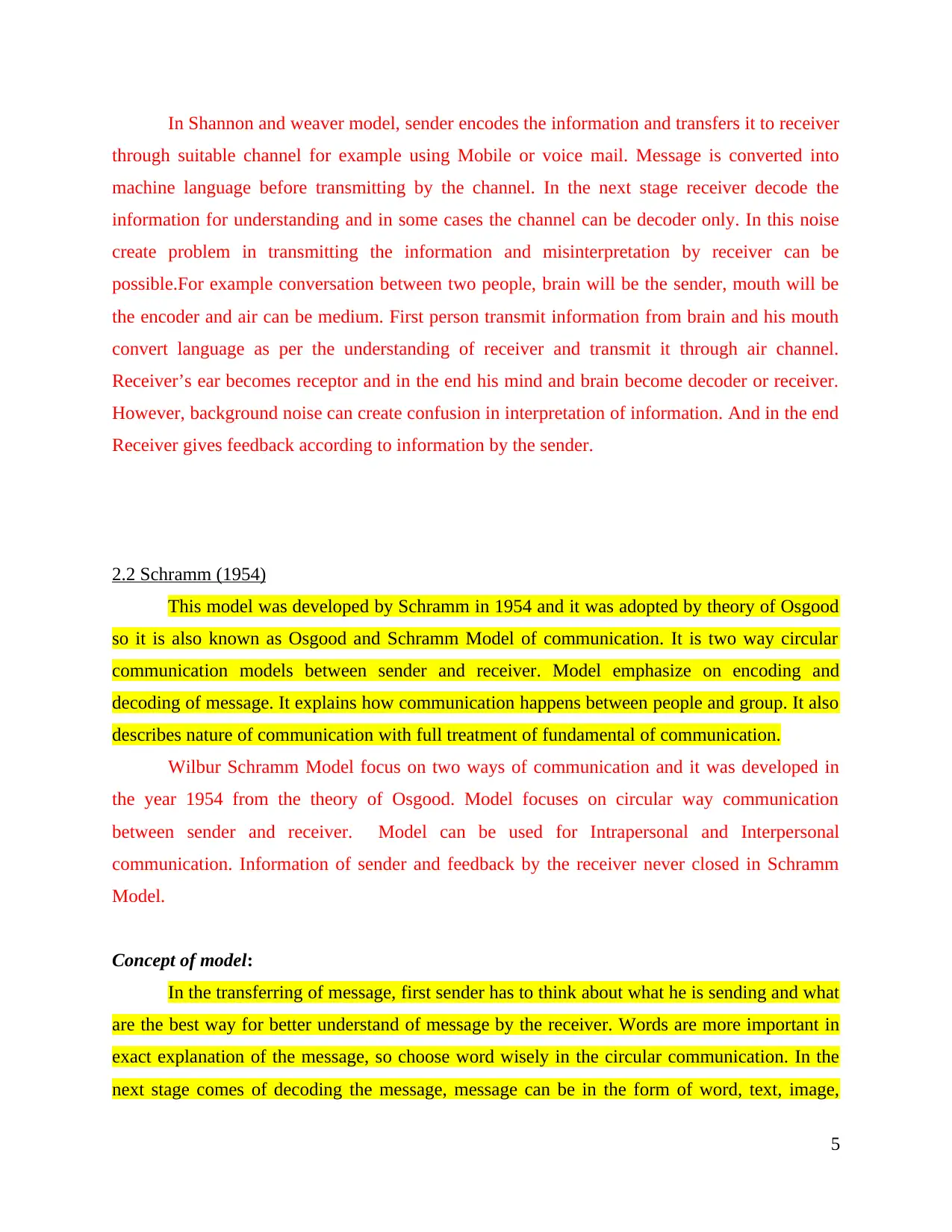
In Shannon and weaver model, sender encodes the information and transfers it to receiver
through suitable channel for example using Mobile or voice mail. Message is converted into
machine language before transmitting by the channel. In the next stage receiver decode the
information for understanding and in some cases the channel can be decoder only. In this noise
create problem in transmitting the information and misinterpretation by receiver can be
possible.For example conversation between two people, brain will be the sender, mouth will be
the encoder and air can be medium. First person transmit information from brain and his mouth
convert language as per the understanding of receiver and transmit it through air channel.
Receiver’s ear becomes receptor and in the end his mind and brain become decoder or receiver.
However, background noise can create confusion in interpretation of information. And in the end
Receiver gives feedback according to information by the sender.
2.2 Schramm (1954)
This model was developed by Schramm in 1954 and it was adopted by theory of Osgood
so it is also known as Osgood and Schramm Model of communication. It is two way circular
communication models between sender and receiver. Model emphasize on encoding and
decoding of message. It explains how communication happens between people and group. It also
describes nature of communication with full treatment of fundamental of communication.
Wilbur Schramm Model focus on two ways of communication and it was developed in
the year 1954 from the theory of Osgood. Model focuses on circular way communication
between sender and receiver. Model can be used for Intrapersonal and Interpersonal
communication. Information of sender and feedback by the receiver never closed in Schramm
Model.
Concept of model:
In the transferring of message, first sender has to think about what he is sending and what
are the best way for better understand of message by the receiver. Words are more important in
exact explanation of the message, so choose word wisely in the circular communication. In the
next stage comes of decoding the message, message can be in the form of word, text, image,
5
through suitable channel for example using Mobile or voice mail. Message is converted into
machine language before transmitting by the channel. In the next stage receiver decode the
information for understanding and in some cases the channel can be decoder only. In this noise
create problem in transmitting the information and misinterpretation by receiver can be
possible.For example conversation between two people, brain will be the sender, mouth will be
the encoder and air can be medium. First person transmit information from brain and his mouth
convert language as per the understanding of receiver and transmit it through air channel.
Receiver’s ear becomes receptor and in the end his mind and brain become decoder or receiver.
However, background noise can create confusion in interpretation of information. And in the end
Receiver gives feedback according to information by the sender.
2.2 Schramm (1954)
This model was developed by Schramm in 1954 and it was adopted by theory of Osgood
so it is also known as Osgood and Schramm Model of communication. It is two way circular
communication models between sender and receiver. Model emphasize on encoding and
decoding of message. It explains how communication happens between people and group. It also
describes nature of communication with full treatment of fundamental of communication.
Wilbur Schramm Model focus on two ways of communication and it was developed in
the year 1954 from the theory of Osgood. Model focuses on circular way communication
between sender and receiver. Model can be used for Intrapersonal and Interpersonal
communication. Information of sender and feedback by the receiver never closed in Schramm
Model.
Concept of model:
In the transferring of message, first sender has to think about what he is sending and what
are the best way for better understand of message by the receiver. Words are more important in
exact explanation of the message, so choose word wisely in the circular communication. In the
next stage comes of decoding the message, message can be in the form of word, text, image,
5
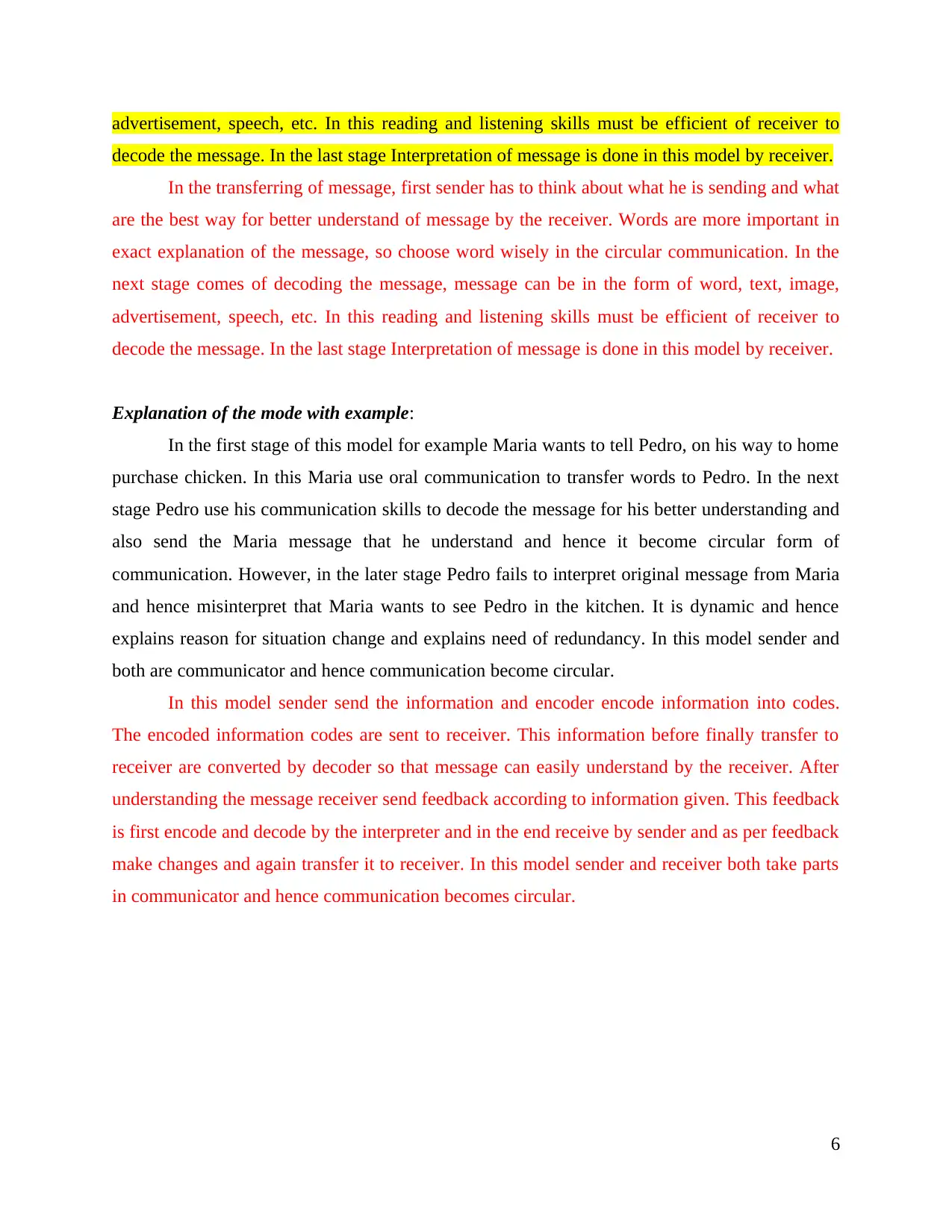
advertisement, speech, etc. In this reading and listening skills must be efficient of receiver to
decode the message. In the last stage Interpretation of message is done in this model by receiver.
In the transferring of message, first sender has to think about what he is sending and what
are the best way for better understand of message by the receiver. Words are more important in
exact explanation of the message, so choose word wisely in the circular communication. In the
next stage comes of decoding the message, message can be in the form of word, text, image,
advertisement, speech, etc. In this reading and listening skills must be efficient of receiver to
decode the message. In the last stage Interpretation of message is done in this model by receiver.
Explanation of the mode with example:
In the first stage of this model for example Maria wants to tell Pedro, on his way to home
purchase chicken. In this Maria use oral communication to transfer words to Pedro. In the next
stage Pedro use his communication skills to decode the message for his better understanding and
also send the Maria message that he understand and hence it become circular form of
communication. However, in the later stage Pedro fails to interpret original message from Maria
and hence misinterpret that Maria wants to see Pedro in the kitchen. It is dynamic and hence
explains reason for situation change and explains need of redundancy. In this model sender and
both are communicator and hence communication become circular.
In this model sender send the information and encoder encode information into codes.
The encoded information codes are sent to receiver. This information before finally transfer to
receiver are converted by decoder so that message can easily understand by the receiver. After
understanding the message receiver send feedback according to information given. This feedback
is first encode and decode by the interpreter and in the end receive by sender and as per feedback
make changes and again transfer it to receiver. In this model sender and receiver both take parts
in communicator and hence communication becomes circular.
6
decode the message. In the last stage Interpretation of message is done in this model by receiver.
In the transferring of message, first sender has to think about what he is sending and what
are the best way for better understand of message by the receiver. Words are more important in
exact explanation of the message, so choose word wisely in the circular communication. In the
next stage comes of decoding the message, message can be in the form of word, text, image,
advertisement, speech, etc. In this reading and listening skills must be efficient of receiver to
decode the message. In the last stage Interpretation of message is done in this model by receiver.
Explanation of the mode with example:
In the first stage of this model for example Maria wants to tell Pedro, on his way to home
purchase chicken. In this Maria use oral communication to transfer words to Pedro. In the next
stage Pedro use his communication skills to decode the message for his better understanding and
also send the Maria message that he understand and hence it become circular form of
communication. However, in the later stage Pedro fails to interpret original message from Maria
and hence misinterpret that Maria wants to see Pedro in the kitchen. It is dynamic and hence
explains reason for situation change and explains need of redundancy. In this model sender and
both are communicator and hence communication become circular.
In this model sender send the information and encoder encode information into codes.
The encoded information codes are sent to receiver. This information before finally transfer to
receiver are converted by decoder so that message can easily understand by the receiver. After
understanding the message receiver send feedback according to information given. This feedback
is first encode and decode by the interpreter and in the end receive by sender and as per feedback
make changes and again transfer it to receiver. In this model sender and receiver both take parts
in communicator and hence communication becomes circular.
6
⊘ This is a preview!⊘
Do you want full access?
Subscribe today to unlock all pages.

Trusted by 1+ million students worldwide
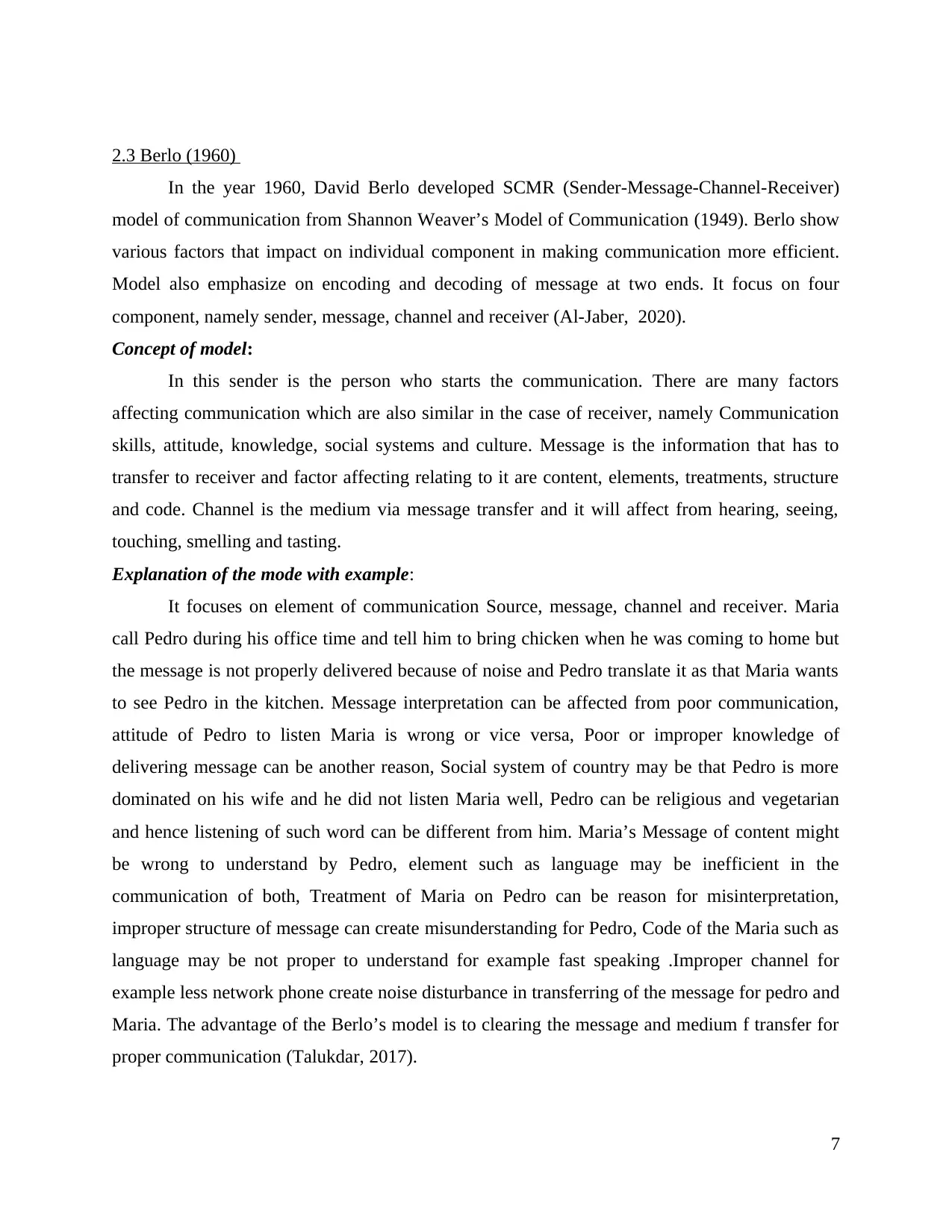
2.3 Berlo (1960)
In the year 1960, David Berlo developed SCMR (Sender-Message-Channel-Receiver)
model of communication from Shannon Weaver’s Model of Communication (1949). Berlo show
various factors that impact on individual component in making communication more efficient.
Model also emphasize on encoding and decoding of message at two ends. It focus on four
component, namely sender, message, channel and receiver (Al-Jaber, 2020).
Concept of model:
In this sender is the person who starts the communication. There are many factors
affecting communication which are also similar in the case of receiver, namely Communication
skills, attitude, knowledge, social systems and culture. Message is the information that has to
transfer to receiver and factor affecting relating to it are content, elements, treatments, structure
and code. Channel is the medium via message transfer and it will affect from hearing, seeing,
touching, smelling and tasting.
Explanation of the mode with example:
It focuses on element of communication Source, message, channel and receiver. Maria
call Pedro during his office time and tell him to bring chicken when he was coming to home but
the message is not properly delivered because of noise and Pedro translate it as that Maria wants
to see Pedro in the kitchen. Message interpretation can be affected from poor communication,
attitude of Pedro to listen Maria is wrong or vice versa, Poor or improper knowledge of
delivering message can be another reason, Social system of country may be that Pedro is more
dominated on his wife and he did not listen Maria well, Pedro can be religious and vegetarian
and hence listening of such word can be different from him. Maria’s Message of content might
be wrong to understand by Pedro, element such as language may be inefficient in the
communication of both, Treatment of Maria on Pedro can be reason for misinterpretation,
improper structure of message can create misunderstanding for Pedro, Code of the Maria such as
language may be not proper to understand for example fast speaking .Improper channel for
example less network phone create noise disturbance in transferring of the message for pedro and
Maria. The advantage of the Berlo’s model is to clearing the message and medium f transfer for
proper communication (Talukdar, 2017).
7
In the year 1960, David Berlo developed SCMR (Sender-Message-Channel-Receiver)
model of communication from Shannon Weaver’s Model of Communication (1949). Berlo show
various factors that impact on individual component in making communication more efficient.
Model also emphasize on encoding and decoding of message at two ends. It focus on four
component, namely sender, message, channel and receiver (Al-Jaber, 2020).
Concept of model:
In this sender is the person who starts the communication. There are many factors
affecting communication which are also similar in the case of receiver, namely Communication
skills, attitude, knowledge, social systems and culture. Message is the information that has to
transfer to receiver and factor affecting relating to it are content, elements, treatments, structure
and code. Channel is the medium via message transfer and it will affect from hearing, seeing,
touching, smelling and tasting.
Explanation of the mode with example:
It focuses on element of communication Source, message, channel and receiver. Maria
call Pedro during his office time and tell him to bring chicken when he was coming to home but
the message is not properly delivered because of noise and Pedro translate it as that Maria wants
to see Pedro in the kitchen. Message interpretation can be affected from poor communication,
attitude of Pedro to listen Maria is wrong or vice versa, Poor or improper knowledge of
delivering message can be another reason, Social system of country may be that Pedro is more
dominated on his wife and he did not listen Maria well, Pedro can be religious and vegetarian
and hence listening of such word can be different from him. Maria’s Message of content might
be wrong to understand by Pedro, element such as language may be inefficient in the
communication of both, Treatment of Maria on Pedro can be reason for misinterpretation,
improper structure of message can create misunderstanding for Pedro, Code of the Maria such as
language may be not proper to understand for example fast speaking .Improper channel for
example less network phone create noise disturbance in transferring of the message for pedro and
Maria. The advantage of the Berlo’s model is to clearing the message and medium f transfer for
proper communication (Talukdar, 2017).
7
Paraphrase This Document
Need a fresh take? Get an instant paraphrase of this document with our AI Paraphraser
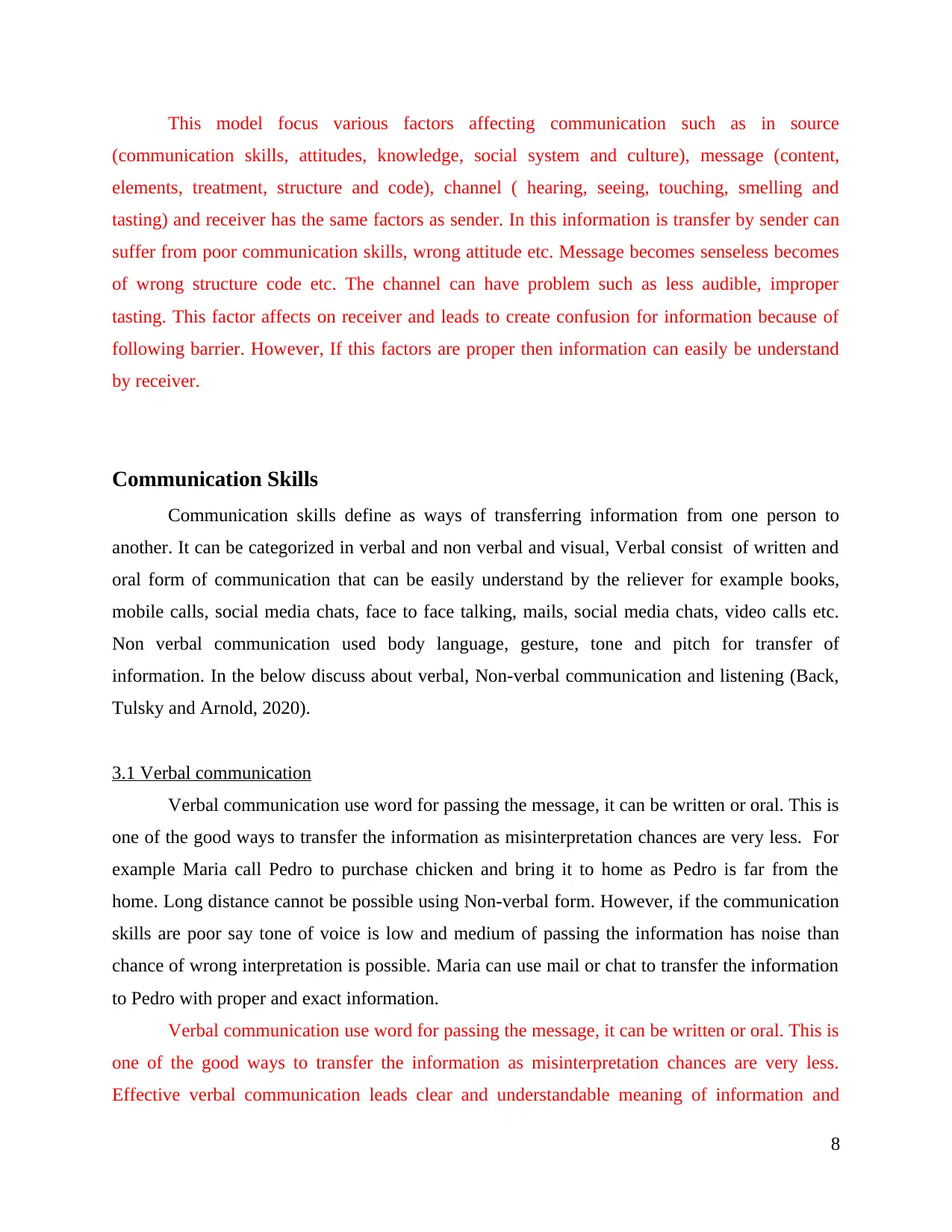
This model focus various factors affecting communication such as in source
(communication skills, attitudes, knowledge, social system and culture), message (content,
elements, treatment, structure and code), channel ( hearing, seeing, touching, smelling and
tasting) and receiver has the same factors as sender. In this information is transfer by sender can
suffer from poor communication skills, wrong attitude etc. Message becomes senseless becomes
of wrong structure code etc. The channel can have problem such as less audible, improper
tasting. This factor affects on receiver and leads to create confusion for information because of
following barrier. However, If this factors are proper then information can easily be understand
by receiver.
Communication Skills
Communication skills define as ways of transferring information from one person to
another. It can be categorized in verbal and non verbal and visual, Verbal consist of written and
oral form of communication that can be easily understand by the reliever for example books,
mobile calls, social media chats, face to face talking, mails, social media chats, video calls etc.
Non verbal communication used body language, gesture, tone and pitch for transfer of
information. In the below discuss about verbal, Non-verbal communication and listening (Back,
Tulsky and Arnold, 2020).
3.1 Verbal communication
Verbal communication use word for passing the message, it can be written or oral. This is
one of the good ways to transfer the information as misinterpretation chances are very less. For
example Maria call Pedro to purchase chicken and bring it to home as Pedro is far from the
home. Long distance cannot be possible using Non-verbal form. However, if the communication
skills are poor say tone of voice is low and medium of passing the information has noise than
chance of wrong interpretation is possible. Maria can use mail or chat to transfer the information
to Pedro with proper and exact information.
Verbal communication use word for passing the message, it can be written or oral. This is
one of the good ways to transfer the information as misinterpretation chances are very less.
Effective verbal communication leads clear and understandable meaning of information and
8
(communication skills, attitudes, knowledge, social system and culture), message (content,
elements, treatment, structure and code), channel ( hearing, seeing, touching, smelling and
tasting) and receiver has the same factors as sender. In this information is transfer by sender can
suffer from poor communication skills, wrong attitude etc. Message becomes senseless becomes
of wrong structure code etc. The channel can have problem such as less audible, improper
tasting. This factor affects on receiver and leads to create confusion for information because of
following barrier. However, If this factors are proper then information can easily be understand
by receiver.
Communication Skills
Communication skills define as ways of transferring information from one person to
another. It can be categorized in verbal and non verbal and visual, Verbal consist of written and
oral form of communication that can be easily understand by the reliever for example books,
mobile calls, social media chats, face to face talking, mails, social media chats, video calls etc.
Non verbal communication used body language, gesture, tone and pitch for transfer of
information. In the below discuss about verbal, Non-verbal communication and listening (Back,
Tulsky and Arnold, 2020).
3.1 Verbal communication
Verbal communication use word for passing the message, it can be written or oral. This is
one of the good ways to transfer the information as misinterpretation chances are very less. For
example Maria call Pedro to purchase chicken and bring it to home as Pedro is far from the
home. Long distance cannot be possible using Non-verbal form. However, if the communication
skills are poor say tone of voice is low and medium of passing the information has noise than
chance of wrong interpretation is possible. Maria can use mail or chat to transfer the information
to Pedro with proper and exact information.
Verbal communication use word for passing the message, it can be written or oral. This is
one of the good ways to transfer the information as misinterpretation chances are very less.
Effective verbal communication leads clear and understandable meaning of information and
8
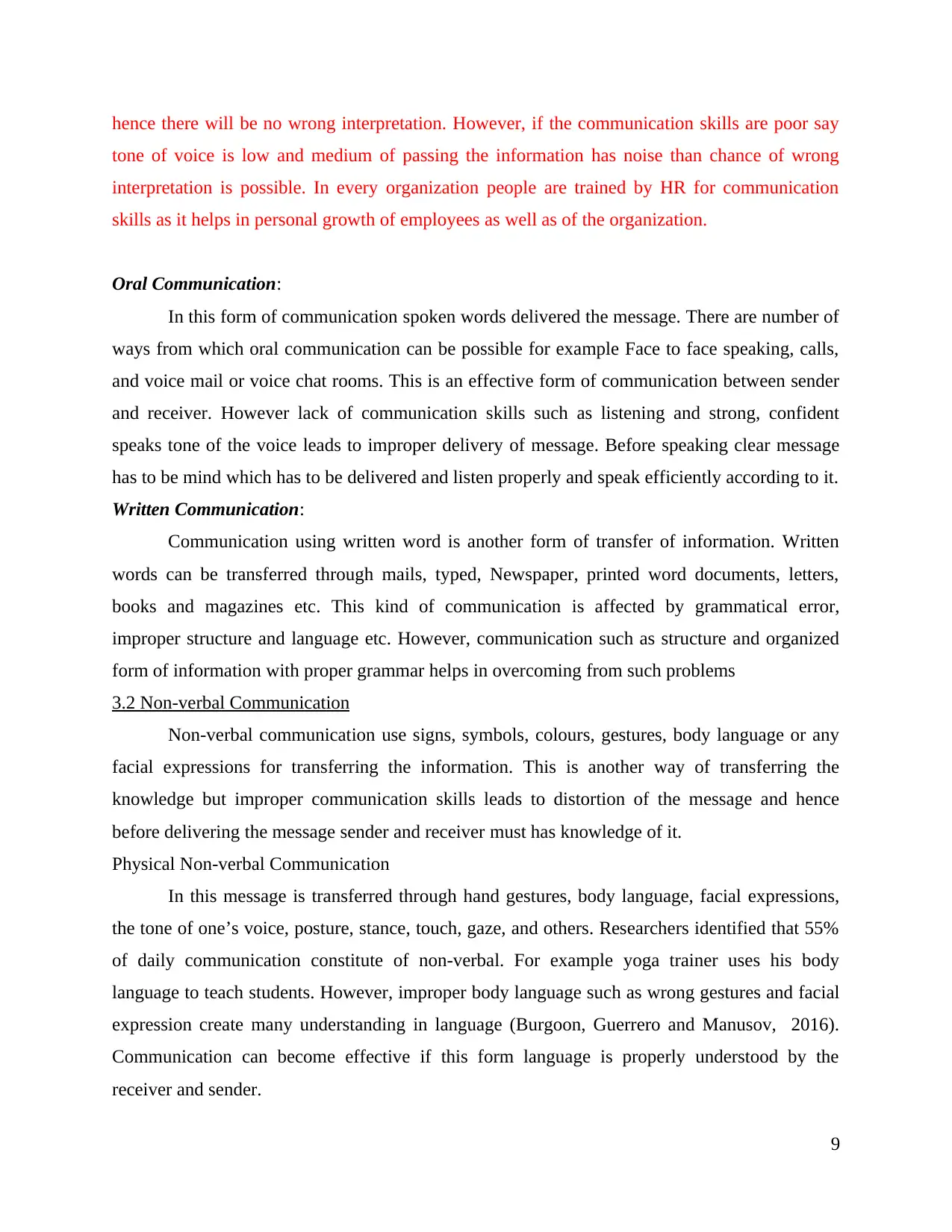
hence there will be no wrong interpretation. However, if the communication skills are poor say
tone of voice is low and medium of passing the information has noise than chance of wrong
interpretation is possible. In every organization people are trained by HR for communication
skills as it helps in personal growth of employees as well as of the organization.
Oral Communication:
In this form of communication spoken words delivered the message. There are number of
ways from which oral communication can be possible for example Face to face speaking, calls,
and voice mail or voice chat rooms. This is an effective form of communication between sender
and receiver. However lack of communication skills such as listening and strong, confident
speaks tone of the voice leads to improper delivery of message. Before speaking clear message
has to be mind which has to be delivered and listen properly and speak efficiently according to it.
Written Communication:
Communication using written word is another form of transfer of information. Written
words can be transferred through mails, typed, Newspaper, printed word documents, letters,
books and magazines etc. This kind of communication is affected by grammatical error,
improper structure and language etc. However, communication such as structure and organized
form of information with proper grammar helps in overcoming from such problems
3.2 Non-verbal Communication
Non-verbal communication use signs, symbols, colours, gestures, body language or any
facial expressions for transferring the information. This is another way of transferring the
knowledge but improper communication skills leads to distortion of the message and hence
before delivering the message sender and receiver must has knowledge of it.
Physical Non-verbal Communication
In this message is transferred through hand gestures, body language, facial expressions,
the tone of one’s voice, posture, stance, touch, gaze, and others. Researchers identified that 55%
of daily communication constitute of non-verbal. For example yoga trainer uses his body
language to teach students. However, improper body language such as wrong gestures and facial
expression create many understanding in language (Burgoon, Guerrero and Manusov, 2016).
Communication can become effective if this form language is properly understood by the
receiver and sender.
9
tone of voice is low and medium of passing the information has noise than chance of wrong
interpretation is possible. In every organization people are trained by HR for communication
skills as it helps in personal growth of employees as well as of the organization.
Oral Communication:
In this form of communication spoken words delivered the message. There are number of
ways from which oral communication can be possible for example Face to face speaking, calls,
and voice mail or voice chat rooms. This is an effective form of communication between sender
and receiver. However lack of communication skills such as listening and strong, confident
speaks tone of the voice leads to improper delivery of message. Before speaking clear message
has to be mind which has to be delivered and listen properly and speak efficiently according to it.
Written Communication:
Communication using written word is another form of transfer of information. Written
words can be transferred through mails, typed, Newspaper, printed word documents, letters,
books and magazines etc. This kind of communication is affected by grammatical error,
improper structure and language etc. However, communication such as structure and organized
form of information with proper grammar helps in overcoming from such problems
3.2 Non-verbal Communication
Non-verbal communication use signs, symbols, colours, gestures, body language or any
facial expressions for transferring the information. This is another way of transferring the
knowledge but improper communication skills leads to distortion of the message and hence
before delivering the message sender and receiver must has knowledge of it.
Physical Non-verbal Communication
In this message is transferred through hand gestures, body language, facial expressions,
the tone of one’s voice, posture, stance, touch, gaze, and others. Researchers identified that 55%
of daily communication constitute of non-verbal. For example yoga trainer uses his body
language to teach students. However, improper body language such as wrong gestures and facial
expression create many understanding in language (Burgoon, Guerrero and Manusov, 2016).
Communication can become effective if this form language is properly understood by the
receiver and sender.
9
⊘ This is a preview!⊘
Do you want full access?
Subscribe today to unlock all pages.

Trusted by 1+ million students worldwide
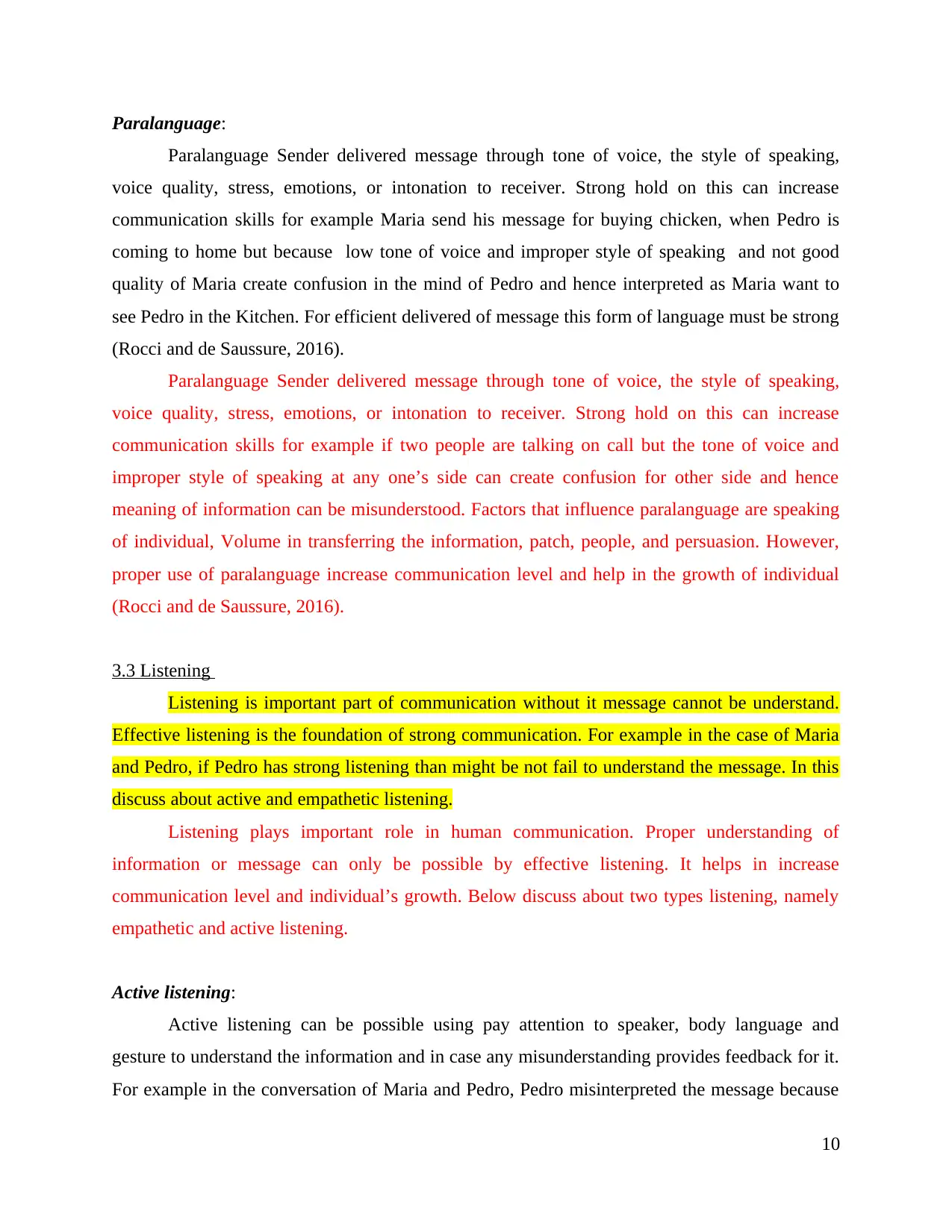
Paralanguage:
Paralanguage Sender delivered message through tone of voice, the style of speaking,
voice quality, stress, emotions, or intonation to receiver. Strong hold on this can increase
communication skills for example Maria send his message for buying chicken, when Pedro is
coming to home but because low tone of voice and improper style of speaking and not good
quality of Maria create confusion in the mind of Pedro and hence interpreted as Maria want to
see Pedro in the Kitchen. For efficient delivered of message this form of language must be strong
(Rocci and de Saussure, 2016).
Paralanguage Sender delivered message through tone of voice, the style of speaking,
voice quality, stress, emotions, or intonation to receiver. Strong hold on this can increase
communication skills for example if two people are talking on call but the tone of voice and
improper style of speaking at any one’s side can create confusion for other side and hence
meaning of information can be misunderstood. Factors that influence paralanguage are speaking
of individual, Volume in transferring the information, patch, people, and persuasion. However,
proper use of paralanguage increase communication level and help in the growth of individual
(Rocci and de Saussure, 2016).
3.3 Listening
Listening is important part of communication without it message cannot be understand.
Effective listening is the foundation of strong communication. For example in the case of Maria
and Pedro, if Pedro has strong listening than might be not fail to understand the message. In this
discuss about active and empathetic listening.
Listening plays important role in human communication. Proper understanding of
information or message can only be possible by effective listening. It helps in increase
communication level and individual’s growth. Below discuss about two types listening, namely
empathetic and active listening.
Active listening:
Active listening can be possible using pay attention to speaker, body language and
gesture to understand the information and in case any misunderstanding provides feedback for it.
For example in the conversation of Maria and Pedro, Pedro misinterpreted the message because
10
Paralanguage Sender delivered message through tone of voice, the style of speaking,
voice quality, stress, emotions, or intonation to receiver. Strong hold on this can increase
communication skills for example Maria send his message for buying chicken, when Pedro is
coming to home but because low tone of voice and improper style of speaking and not good
quality of Maria create confusion in the mind of Pedro and hence interpreted as Maria want to
see Pedro in the Kitchen. For efficient delivered of message this form of language must be strong
(Rocci and de Saussure, 2016).
Paralanguage Sender delivered message through tone of voice, the style of speaking,
voice quality, stress, emotions, or intonation to receiver. Strong hold on this can increase
communication skills for example if two people are talking on call but the tone of voice and
improper style of speaking at any one’s side can create confusion for other side and hence
meaning of information can be misunderstood. Factors that influence paralanguage are speaking
of individual, Volume in transferring the information, patch, people, and persuasion. However,
proper use of paralanguage increase communication level and help in the growth of individual
(Rocci and de Saussure, 2016).
3.3 Listening
Listening is important part of communication without it message cannot be understand.
Effective listening is the foundation of strong communication. For example in the case of Maria
and Pedro, if Pedro has strong listening than might be not fail to understand the message. In this
discuss about active and empathetic listening.
Listening plays important role in human communication. Proper understanding of
information or message can only be possible by effective listening. It helps in increase
communication level and individual’s growth. Below discuss about two types listening, namely
empathetic and active listening.
Active listening:
Active listening can be possible using pay attention to speaker, body language and
gesture to understand the information and in case any misunderstanding provides feedback for it.
For example in the conversation of Maria and Pedro, Pedro misinterpreted the message because
10
Paraphrase This Document
Need a fresh take? Get an instant paraphrase of this document with our AI Paraphraser
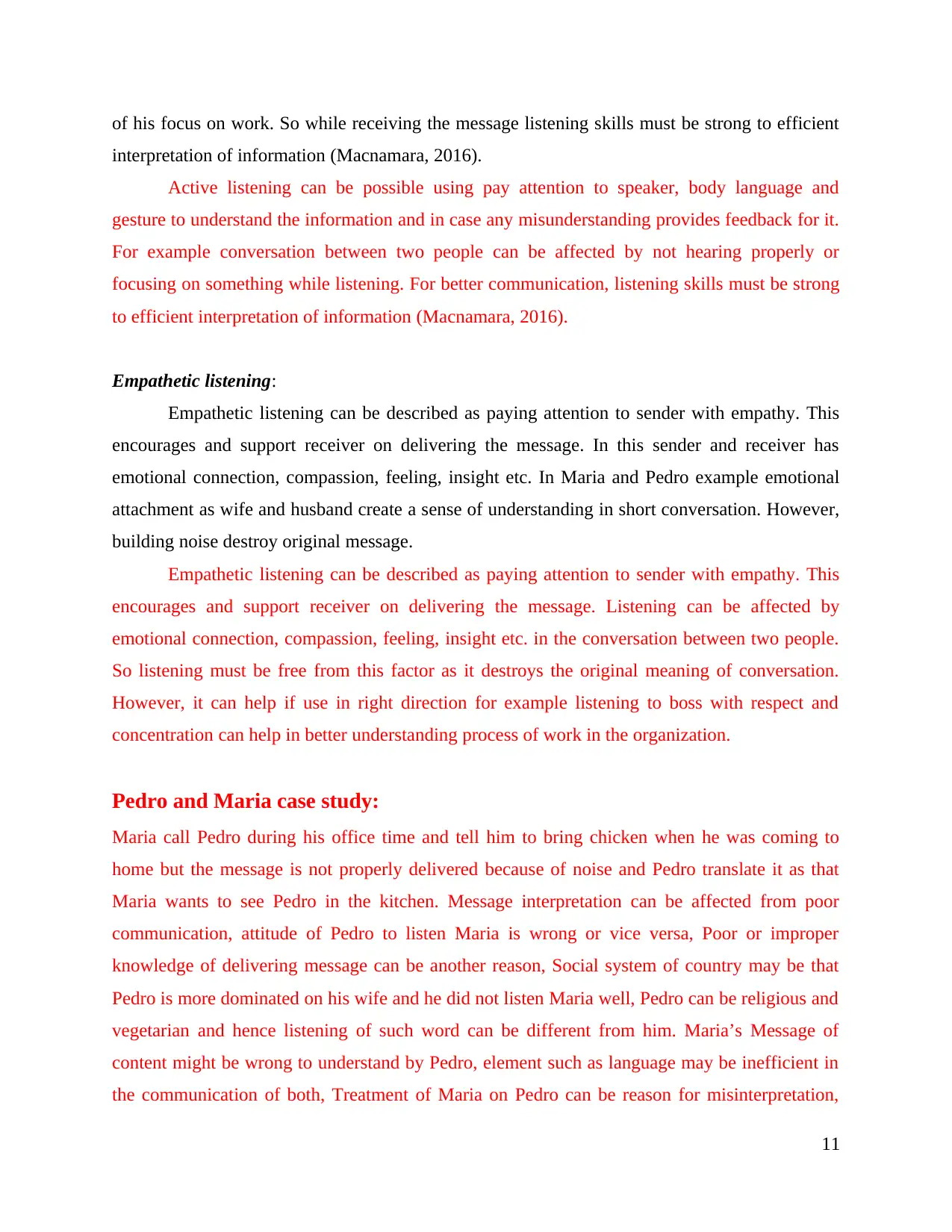
of his focus on work. So while receiving the message listening skills must be strong to efficient
interpretation of information (Macnamara, 2016).
Active listening can be possible using pay attention to speaker, body language and
gesture to understand the information and in case any misunderstanding provides feedback for it.
For example conversation between two people can be affected by not hearing properly or
focusing on something while listening. For better communication, listening skills must be strong
to efficient interpretation of information (Macnamara, 2016).
Empathetic listening:
Empathetic listening can be described as paying attention to sender with empathy. This
encourages and support receiver on delivering the message. In this sender and receiver has
emotional connection, compassion, feeling, insight etc. In Maria and Pedro example emotional
attachment as wife and husband create a sense of understanding in short conversation. However,
building noise destroy original message.
Empathetic listening can be described as paying attention to sender with empathy. This
encourages and support receiver on delivering the message. Listening can be affected by
emotional connection, compassion, feeling, insight etc. in the conversation between two people.
So listening must be free from this factor as it destroys the original meaning of conversation.
However, it can help if use in right direction for example listening to boss with respect and
concentration can help in better understanding process of work in the organization.
Pedro and Maria case study:
Maria call Pedro during his office time and tell him to bring chicken when he was coming to
home but the message is not properly delivered because of noise and Pedro translate it as that
Maria wants to see Pedro in the kitchen. Message interpretation can be affected from poor
communication, attitude of Pedro to listen Maria is wrong or vice versa, Poor or improper
knowledge of delivering message can be another reason, Social system of country may be that
Pedro is more dominated on his wife and he did not listen Maria well, Pedro can be religious and
vegetarian and hence listening of such word can be different from him. Maria’s Message of
content might be wrong to understand by Pedro, element such as language may be inefficient in
the communication of both, Treatment of Maria on Pedro can be reason for misinterpretation,
11
interpretation of information (Macnamara, 2016).
Active listening can be possible using pay attention to speaker, body language and
gesture to understand the information and in case any misunderstanding provides feedback for it.
For example conversation between two people can be affected by not hearing properly or
focusing on something while listening. For better communication, listening skills must be strong
to efficient interpretation of information (Macnamara, 2016).
Empathetic listening:
Empathetic listening can be described as paying attention to sender with empathy. This
encourages and support receiver on delivering the message. In this sender and receiver has
emotional connection, compassion, feeling, insight etc. In Maria and Pedro example emotional
attachment as wife and husband create a sense of understanding in short conversation. However,
building noise destroy original message.
Empathetic listening can be described as paying attention to sender with empathy. This
encourages and support receiver on delivering the message. Listening can be affected by
emotional connection, compassion, feeling, insight etc. in the conversation between two people.
So listening must be free from this factor as it destroys the original meaning of conversation.
However, it can help if use in right direction for example listening to boss with respect and
concentration can help in better understanding process of work in the organization.
Pedro and Maria case study:
Maria call Pedro during his office time and tell him to bring chicken when he was coming to
home but the message is not properly delivered because of noise and Pedro translate it as that
Maria wants to see Pedro in the kitchen. Message interpretation can be affected from poor
communication, attitude of Pedro to listen Maria is wrong or vice versa, Poor or improper
knowledge of delivering message can be another reason, Social system of country may be that
Pedro is more dominated on his wife and he did not listen Maria well, Pedro can be religious and
vegetarian and hence listening of such word can be different from him. Maria’s Message of
content might be wrong to understand by Pedro, element such as language may be inefficient in
the communication of both, Treatment of Maria on Pedro can be reason for misinterpretation,
11
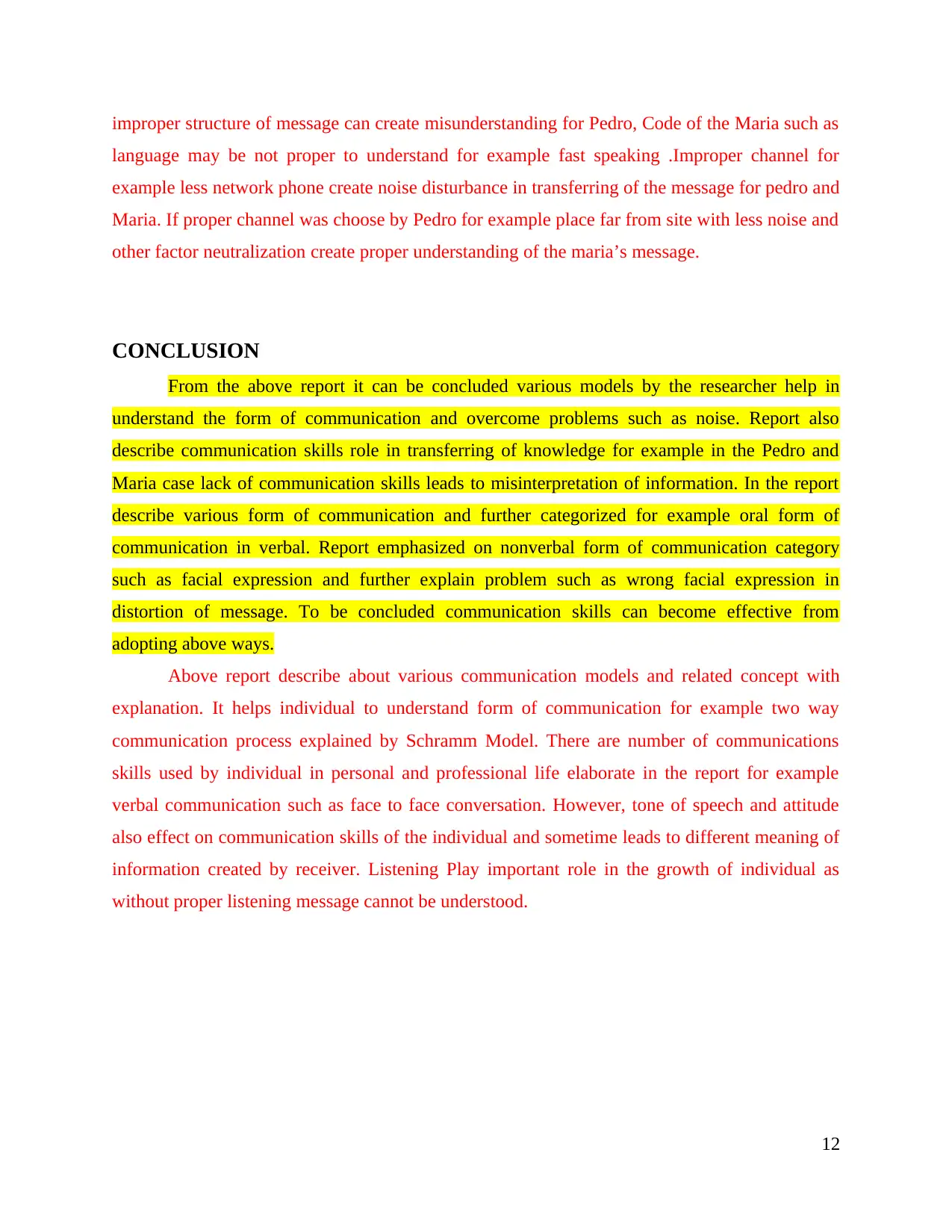
improper structure of message can create misunderstanding for Pedro, Code of the Maria such as
language may be not proper to understand for example fast speaking .Improper channel for
example less network phone create noise disturbance in transferring of the message for pedro and
Maria. If proper channel was choose by Pedro for example place far from site with less noise and
other factor neutralization create proper understanding of the maria’s message.
CONCLUSION
From the above report it can be concluded various models by the researcher help in
understand the form of communication and overcome problems such as noise. Report also
describe communication skills role in transferring of knowledge for example in the Pedro and
Maria case lack of communication skills leads to misinterpretation of information. In the report
describe various form of communication and further categorized for example oral form of
communication in verbal. Report emphasized on nonverbal form of communication category
such as facial expression and further explain problem such as wrong facial expression in
distortion of message. To be concluded communication skills can become effective from
adopting above ways.
Above report describe about various communication models and related concept with
explanation. It helps individual to understand form of communication for example two way
communication process explained by Schramm Model. There are number of communications
skills used by individual in personal and professional life elaborate in the report for example
verbal communication such as face to face conversation. However, tone of speech and attitude
also effect on communication skills of the individual and sometime leads to different meaning of
information created by receiver. Listening Play important role in the growth of individual as
without proper listening message cannot be understood.
12
language may be not proper to understand for example fast speaking .Improper channel for
example less network phone create noise disturbance in transferring of the message for pedro and
Maria. If proper channel was choose by Pedro for example place far from site with less noise and
other factor neutralization create proper understanding of the maria’s message.
CONCLUSION
From the above report it can be concluded various models by the researcher help in
understand the form of communication and overcome problems such as noise. Report also
describe communication skills role in transferring of knowledge for example in the Pedro and
Maria case lack of communication skills leads to misinterpretation of information. In the report
describe various form of communication and further categorized for example oral form of
communication in verbal. Report emphasized on nonverbal form of communication category
such as facial expression and further explain problem such as wrong facial expression in
distortion of message. To be concluded communication skills can become effective from
adopting above ways.
Above report describe about various communication models and related concept with
explanation. It helps individual to understand form of communication for example two way
communication process explained by Schramm Model. There are number of communications
skills used by individual in personal and professional life elaborate in the report for example
verbal communication such as face to face conversation. However, tone of speech and attitude
also effect on communication skills of the individual and sometime leads to different meaning of
information created by receiver. Listening Play important role in the growth of individual as
without proper listening message cannot be understood.
12
⊘ This is a preview!⊘
Do you want full access?
Subscribe today to unlock all pages.

Trusted by 1+ million students worldwide
1 out of 15
Related Documents
Your All-in-One AI-Powered Toolkit for Academic Success.
+13062052269
info@desklib.com
Available 24*7 on WhatsApp / Email
![[object Object]](/_next/static/media/star-bottom.7253800d.svg)
Unlock your academic potential
Copyright © 2020–2025 A2Z Services. All Rights Reserved. Developed and managed by ZUCOL.


![Communication Skills and Teamwork Report - [University Name]](/_next/image/?url=https%3A%2F%2Fdesklib.com%2Fmedia%2Fimages%2Fdg%2Fd5d6ddc7445b4c8c89ea35868f8057d3.jpg&w=256&q=75)

